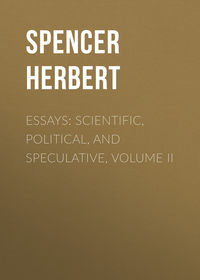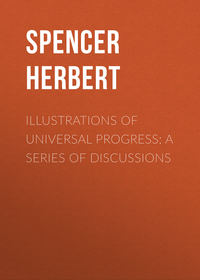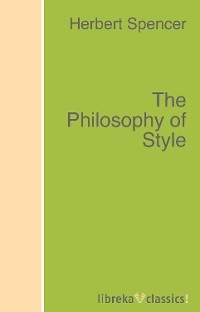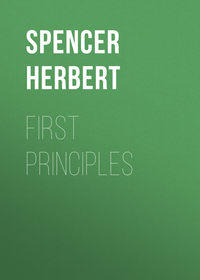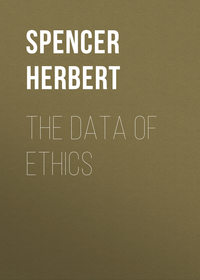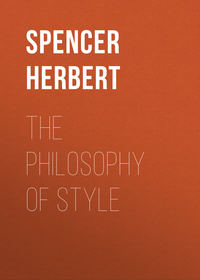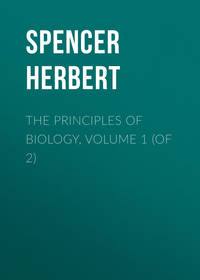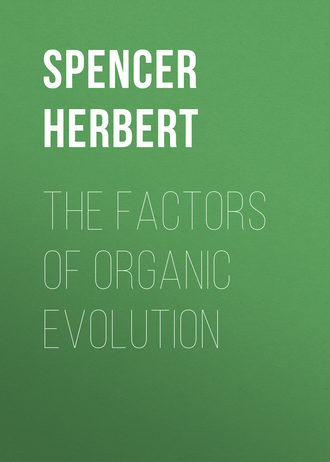 полная версия
полная версияThe Factors of Organic Evolution
Difficulties of another class may next be exemplified – those which present themselves when we ask how there can be effected by the selection of favourable variations, such changes of structure as adapt an organism to some useful action in which many different parts co-operate. None can fail to see how a simple part may, in course of generations, be greatly enlarged, if each enlargement furthers, in some decided way, maintenance of the species. It is easy to understand, too, how a complex part, as an entire limb, may be increased as a whole by the simultaneous due increase of its co-operative parts; since if, while it is growing, the channels of supply bring to the limb an unusual quantity of blood, there will naturally result a proportionately greater size of all its components – bones, muscles, arteries, veins, &c. But though in cases like this, the co-operative parts forming some large complex part may be expected to vary together, nothing implies that they necessarily do so; and we have proof that in various cases, even when closely united, they do not do so. An example is furnished by those blind crabs named in the Origin of Species which inhabit certain dark caves of Kentucky, and which, though they have lost their eyes, have not lost the foot-stalks which carried their eyes. In describing the varieties which have been produced by pigeon-fanciers, Mr. Darwin notes the fact that along with changes in length of beak produced by selection, there have not gone proportionate changes in length of tongue. Take again the case of teeth and jaws. In mankind these have not varied together. During civilization the jaws have decreased, but the teeth have not decreased in proportion; and hence that prevalent crowding of them, often remedied in childhood by extraction of some, and in other cases causing that imperfect development which is followed by early decay. But the absence of proportionate variation in co-operative parts that are close together, and are even bound up in the same mass, is best seen in those varieties of dogs named above as illustrating the inherited effects of disuse. We see in them, as we see in the human race, that diminution in the jaws has not been accompanied by corresponding diminution in the teeth. In the catalogue of the College of Surgeons Museum, there is appended to the entry which identifies a Blenheim Spaniel's skull, the words – “the teeth are closely crowded together,” and to the entry concerning the skull of a King Charles's Spaniel the words – “the teeth are closely packed, p. 3, is placed quite transversely to the axis of the skull.” It is further noteworthy that in a case where there is no diminished use of the jaws, but where they have been shortened by selection, a like want of concomitant variation is manifested: the case being that of the bull-dog, in the upper jaw of which also, “the premolars … are excessively crowded, and placed obliquely or even transversely to the long axis of the skull.”1
If, then, in cases where we can test it, we find no concomitant variation in co-operative parts that are near together – if we do not find it in parts which, though belonging to different tissues, are so closely united as teeth and jaws – if we do not find it even when the co-operative parts are not only closely united, but are formed out of the same tissue, like the crab's eye and its peduncle; what shall we say of co-operative parts which, besides being composed of different tissues, are remote from one another? Not only are we forbidden to assume that they vary together, but we are warranted in asserting that they can have no tendency to vary together. And what are the implications in cases where increase of a structure can be of no service unless there is concomitant increase in many distant structures, which have to join it in performing the action for which it is useful?
As far back as 1864 (Principles of Biology, § 166) I named in illustration an animal carrying heavy horns – the extinct Irish elk; and indicated the many changes in bones, muscles, blood-vessels, nerves, composing the fore-part of the body, which would be required to make an increment of size in such horns advantageous. Here let me take another instance – that of the giraffe: an instance which I take partly because, in the sixth edition of the Origin of Species, issued in 1872, Mr. Darwin has referred to this animal when effectually disposing of certain arguments urged against his hypothesis. He there says: —
“In order that an animal should acquire some structure specially and largely developed, it is almost indispensable that several other parts should be modified and co-adapted. Although every part of the body varies slightly, it does not follow that the necessary parts should always vary in the right direction and to the right degree” (p. 179).
And in the summary of the chapter, he remarks concerning the adjustments in the same quadruped, that “the prolonged use of all the parts together with inheritance will have aided in an important manner in their co-ordination” (p. 199): a remark probably having reference chiefly to the increased massiveness of the lower part of the neck; the increased size and strength of the thorax required to bear the additional burden; and the increased strength of the fore-legs required to carry the greater weight of both. But now I think that further consideration suggests the belief that the entailed modifications are much more numerous and remote than at first appears; and that the greater part of these are such as cannot be ascribed in any degree to the selection of favourable variations, but must be ascribed exclusively to the inherited effects of changed functions. Whoever has seen a giraffe gallop will long remember the sight as a ludicrous one. The reason for the strangeness of the motions is obvious. Though the fore limbs and the hind limbs differ so much in length, yet in galloping they have to keep pace – must take equal strides. The result is that at each stride, the angle which the hind limbs describe round their centre of motion is much larger than the angle described by the fore limbs. And beyond this, as an aid in equalizing the strides, the hind part of the back is at each stride bent very much downwards and forwards. Hence the hind-quarters appear to be doing nearly all the work. Now a moment's observation shows that the bones and muscles composing the hind-quarters of the giraffe, perform actions differing in one or other way and degree, from the actions performed by the homologous bones and muscles in a mammal of ordinary proportions, and from those in the ancestral mammal which gave origin to the giraffe. Each further stage of that growth which produced the large fore-quarters and neck, entailed some adapted change in sundry of the numerous parts composing the hind-quarters; since any failure in the adjustment of their respective strengths would entail some defect in speed and consequent loss of life when chased. It needs but to remember how, when continuing to walk with a blistered foot, the taking of steps in such a modified way as to diminish pressure on the sore point, soon produces aching of muscles which are called into unusual action, to see that over-straining of any one of the muscles of the giraffe's hind-quarters might quickly incapacitate the animal when putting out all its powers to escape; and to be a few yards behind others would cause death. Hence if we are debarred from assuming that co-operative parts vary together even when adjacent and closely united – if we are still more debarred from assuming that with increased length of fore-legs or of neck, there will go an appropriate change in any one muscle or bone in the hind-quarters; how entirely out of the question it is to assume that there will simultaneously take place the appropriate changes in all those many components of the hind-quarters which severally require re-adjustment. It is useless to reply that an increment of length in the fore-legs or neck might be retained and transmitted to posterity, waiting an appropriate variation in a particular bone or muscle in the hind-quarters, which, being made, would allow of a further increment. For besides the fact that until this secondary variation occurred the primary variation would be a disadvantage often fatal; and besides the fact that before such an appropriate secondary variation might be expected in the course of generations to occur, the primary variation would have died out; there is the fact that the appropriate variation of one bone or muscle in the hind-quarters would be useless without appropriate variations of all the rest – some in this way and some in that – a number of appropriate variations which it is impossible to suppose.
Nor is this all. Far more numerous appropriate variations would be indirectly necessitated. The immense change in the ratio of fore-quarters to hind-quarters would make requisite a corresponding change of ratio in the appliances carrying on the nutrition of the two. The entire vascular system, arterial and veinous, would have to undergo successive unbuildings and rebuildings to make its channels everywhere adequate to the local requirements; since any want of adjustment in the blood-supply in this or that set of muscles, would entail incapacity, failure of speed, and loss of life. Moreover the nerves supplying the various sets of muscles would have to be proportionately changed; as well as the central nervous tracts from which they issued. Can we suppose that all these appropriate changes, too, would be step by step simultaneously made by fortunate spontaneous variations, occurring along with all the other fortunate spontaneous variations? Considering how immense must be the number of these required changes, added to the changes above enumerated, the chances against any adequate re-adjustments fortuitously arising must be infinity to one.
If the effects of use and disuse of parts are inheritable, then any change in the fore parts of the giraffe which affects the action of the hind limbs and back, will simultaneously cause, by the greater or less exercise of it, a re-moulding of each component in the hind limbs and back in a way adapted to the new demands; and generation after generation the entire structure of the hind-quarters will be progressively fitted to the changed structure of the fore-quarters: all the appliances for nutrition and innervation being at the same time progressively fitted to both. But in the absence of this inheritance of functionally-produced modifications, there is no seeing how the required re-adjustments can be made.
Yet a third class of difficulties stands in the way of the belief that the natural selection of useful variations is the sole factor of organic evolution. This class of difficulties, already pointed out in § 166 of the Principles of Biology, I cannot more clearly set forth than in the words there used. Hence I may perhaps be excused for here quoting them.
“Where the life is comparatively simple, or where surrounding circumstances render some one function supremely important, the survival of the fittest may readily bring about the appropriate structural change, without any aid from the transmission of functionally-acquired modifications. But in proportion as the life grows complex – in proportion as a healthy existence cannot be secured by a large endowment of some one power, but demands many powers; in the same proportion do there arise obstacles to the increase of any particular power, by “the preservation of favoured races in the struggle for life.” As fast as the faculties are multiplied, so fast does it become possible for the several members of a species to have various kinds of superiorities over one another. While one saves its life by higher speed, another does the like by clearer vision, another by keener scent, another by quicker hearing, another by greater strength, another by unusual power of enduring cold or hunger, another by special sagacity, another by special timidity, another by special courage; and others by other bodily and mental attributes. Now it is unquestionably true that, other things equal, each of these attributes, giving its possessor an extra chance of life, is likely to be transmitted to posterity. But there seems no reason to suppose that it will be increased in subsequent generations by natural selection. That it may be thus increased, the individuals not possessing more than average endowments of it, must be more frequently killed off than individuals highly endowed with it; and this can happen only when the attribute is one of greater importance, for the time being, than most of the other attributes. If those members of the species which have but ordinary shares of it, nevertheless survive by virtue of other superiorities which they severally possess; then it is not easy to see how this particular attribute can be developed by natural selection in subsequent generations. The probability seems rather to be, that by gamogenesis, this extra endowment will, on the average, be diminished in posterity – just serving in the long run to compensate the deficient endowments of other individuals, whose special powers lie in other directions; and so to keep up the normal structure of the species. The working out of the process is here somewhat difficult to follow; but it appears to me that as fast as the number of bodily and mental faculties increases, and as fast as the maintenance of life comes to depend less on the amount of any one, and more on the combined action of all; so fast does the production of specialities of character by natural selection alone, become difficult. Particularly does this seem to be so with a species so multitudinous in its powers as mankind; and above all does it seem to be so with such of the human powers as have but minor shares in aiding the struggle for life – the æsthetic faculties, for example.”
Dwelling for a moment on this last illustration of the class of difficulties described, let us ask how we are to interpret the development of the musical faculty. I will not enlarge on the family antecedents of the great composers. I will merely suggest the inquiry whether the greater powers possessed by Beethoven and Mozart, by Weber and Rossini, than by their fathers, were not due in larger measure to the inherited effects of daily exercise of the musical faculty by their fathers, than to inheritance, with increase, of spontaneous variations; and whether the diffused musical powers of the Bach clan, culminating in those of Johann Sebastian, did not result in part from constant practice; but I will raise the more general question – How came there that endowment of musical faculty which characterizes modern Europeans at large, as compared with their remote ancestors. The monotonous chants of low savages cannot be said to show any melodic inspiration; and it is not evident that an individual savage who had a little more musical perception than the rest, would derive any such advantage in the maintenance of life as would secure the spread of his superiority by inheritance of the variation. And then what are we to say of harmony? We cannot suppose that the appreciation of this, which is relatively modern, can have arisen by descent from the men in whom successive variations increased the appreciation of it – the composers and musical performers; for on the whole, these have been men whose worldly prosperity was not such as enabled them to rear many children inheriting their special traits. Even if we count the illegitimate ones, the survivors of these added to the survivors of the legitimate ones, can hardly be held to have yielded more than average numbers of descendants; and those who inherited their special traits have not often been thereby so aided in the struggle for existence as to further the spread of such traits. Rather the tendency seems to have been the reverse.
Since the above passage was written, I have found in the second volume of Animals and Plants under Domestication, a remark made by Mr. Darwin, practically implying that among creatures which depend for their lives on the efficiency of numerous powers, the increase of any one by the natural selection of a variation is necessarily difficult. Here it is.
“Finally, as indefinite and almost illimitable variability is the usual result of domestication and cultivation, with the same part or organ varying in different individuals in different or even in directly opposite ways; and as the same variation, if strongly pronounced, usually recurs only after long intervals of time, any particular variation would generally be lost by crossing, reversion, and the accidental destruction of the varying individuals, unless carefully preserved by man.” – Vol. ii, 292.
Remembering that mankind, subject as they are to this domestication and cultivation, are not, like domesticated animals, under an agency which picks out and preserves particular variations; it results that there must usually be among them, under the influence of natural selection alone, a continual disappearance of any useful variations of particular faculties which may arise. Only in cases of variations which are specially preservative, as for example, great cunning during a relatively barbarous state, can we expect increase from natural selection alone. We cannot suppose that minor traits, exemplified among others by the æsthetic perceptions, can have been evolved by natural selection. But if there is inheritance of functionally-produced modifications of structure, evolution of such minor traits is no longer inexplicable.
Two remarks made by Mr. Darwin have implications from which the same general conclusion must, I think, be drawn. Speaking of the variability of animals and plants under domestication, he says: —
“Changes of any kind in the conditions of life, even extremely slight changes, often suffice to cause variability… Animals and plants continue to be variable for an immense period after their first domestication; … In the course of time they can be habituated to certain changes, so as to become less variable; … There is good evidence that the power of changed conditions accumulates; so that two, three, or more generations must be exposed to new conditions before any effect is visible… Some variations are induced by the direct action of the surrounding conditions on the whole organization, or on certain parts alone, and other variations are induced indirectly through the reproductive system being affected in the same manner as is so common with organic beings when removed from their natural conditions.” – (Animals and Plants under Domestication, vol. ii, 270.)
There are to be recognized two modes of this effect produced by changed conditions on the reproductive system, and consequently on offspring. Simple arrest of development is one. But beyond the variations of offspring arising from imperfectly developed reproductive systems in parents – variations which must be ordinarily in the nature of imperfections – there are others due to a changed balance of functions caused by changed conditions. The fact noted by Mr. Darwin in the above passage, “that the power of changed conditions accumulates; so that two, three, or more generations must be exposed to new conditions before any effect is visible,” implies that during these generations there is going on some change of constitution consequent on the changed proportions and relations of the functions. I will not dwell on the implication, which seems tolerably clear, that this change must consist of such modifications of organs as adapt them to their changed functions; and that if the influence of changed conditions “accumulates,” it must be through the inheritance of such modifications. Nor will I press the question – What is the nature of the effect registered in the reproductive elements, and which is subsequently manifested by variations? – Is it an effect entirely irrelevant to the new requirements of the variety? – Or is it an effect which makes the variety less fit for the new requirements? – Or is it an effect which makes it more fit for the new requirements? But not pressing these questions, it suffices to point out the necessary implication that changed functions of organs do, in some way or other, register themselves in changed proclivities of the reproductive elements. In face of these facts it cannot be denied that the modified action of a part produces an inheritable effect – be the nature of that effect what it may.
The second of the remarks above adverted to as made by Mr. Darwin, is contained in his sections dealing with correlated variations. In the Origin of Species, p. 114, he says —
“The whole organization is so tied together during its growth and development, that when slight variations in any one part occur, and are accumulated through natural selection, other parts become modified.”
And a parallel statement contained in Animals and Plants under Domestication, vol. ii, p. 320, runs thus —
“Correlated variation is an important subject for us; for when one part is modified through continued selection, either by man or under nature, other parts of the organization will be unavoidably modified. From this correlation it apparently follows that, with our domesticated animals and plants, varieties rarely or never differ from each other by some single character alone.”
By what process does a changed part modify other parts? By modifying their functions in some way or degree, seems the necessary answer. It is indeed, imaginable, that where the part changed is some dermal appendage which, becoming larger, has abstracted more of the needful material from the general stock, the effect may consist simply in diminishing the amount of this material available for other dermal appendages, leading to diminution of some or all of them, and may fail to affect in appreciable ways the rest of the organism: save perhaps the blood-vessels near the enlarged appendage. But where the part is an active one – a limb, or viscus, or any organ which constantly demands blood, produces waste matter, secretes, or absorbs – then all the other active organs become implicated in the change. The functions performed by them have to constitute a moving equilibrium; and the function of one cannot, by alteration of the structure performing it, be modified in degree or kind, without modifying the functions of the rest – some appreciably and others inappreciably, according to the directness or indirectness of their relations. Of such inter-dependent changes, the normal ones are naturally inconspicuous; but those which are partially or completely abnormal, sufficiently carry home the general truth. Thus, unusual cerebral excitement affects the excretion through the kidneys in quantity or quality or both. Strong emotions of disagreeable kinds check or arrest the flow of bile. A considerable obstacle to the circulation offered by some important structure in a diseased or disordered state, throwing more strain upon the heart, causes hypertrophy of its muscular walls; and this change which is, so far as concerns the primary evil, a remedial one, often entails mischiefs in other organs. “Apoplexy and palsy, in a scarcely credible number of cases, are directly dependent on hypertrophic enlargement of the heart.” And in other cases, asthma, dropsy, and epilepsy are caused. Now if a result of this inter-dependence as seen in the individual organism, is that a local modification of one part produces, by changing their functions, correlative modifications of other parts, then the question here to be put is – Are these correlative modifications, when of a kind falling within normal limits, inheritable or not. If they are inheritable, then the fact stated by Mr. Darwin that “when one part is modified through continued selection,” “other parts of the organization will be unavoidably modified” is perfectly intelligible: these entailed secondary modifications are transmitted pari passu with the successive modifications produced by selection. But what if they are not inheritable? Then these secondary modifications caused in the individual, not being transmitted to descendants, the descendants must commence life with organizations out of balance, and with each increment of change in the part affected by selection, their organizations must get more out of balance – must have a larger and larger amounts of re-organization to be made during their lives. Hence the constitution of the variety must become more and more unworkable.
The only imaginable alternative is that the re-adjustments are effected in course of time by natural selection. But, in the first place, as we find no proof of concomitant variation among directly co-operative parts which are closely united, there cannot be assumed any concomitant variation among parts which are both indirectly co-operative and far from one another. And, in the second place, before all the many required re-adjustments could be made, the variety would die out from defective constitution. Even were there no such difficulty, we should still have to entertain a strange group of propositions, which would stand as follows: – 1. Change in one part entails, by reaction on the organism, changes, in other parts, the functions of which are necessarily changed. 2. Such changes worked in the individual, affect, in some way, the reproductive elements: these being found to evolve unusual structures when the constitutional balance has been continuously disturbed. 3. But the changes in the reproductive elements thus caused, are not such as represent these functionally-produced changes: the modifications conveyed to offspring are irrelevant to these various modifications functionally produced in the organs of the parents. 4. Nevertheless, while the balance of functions cannot be re-established through inheritance of the effects of disturbed functions on structures, wrought throughout the individual organism; it can be re-established by the inheritance of fortuitous variations which occur in all the affected organs without reference to these changes of function.


